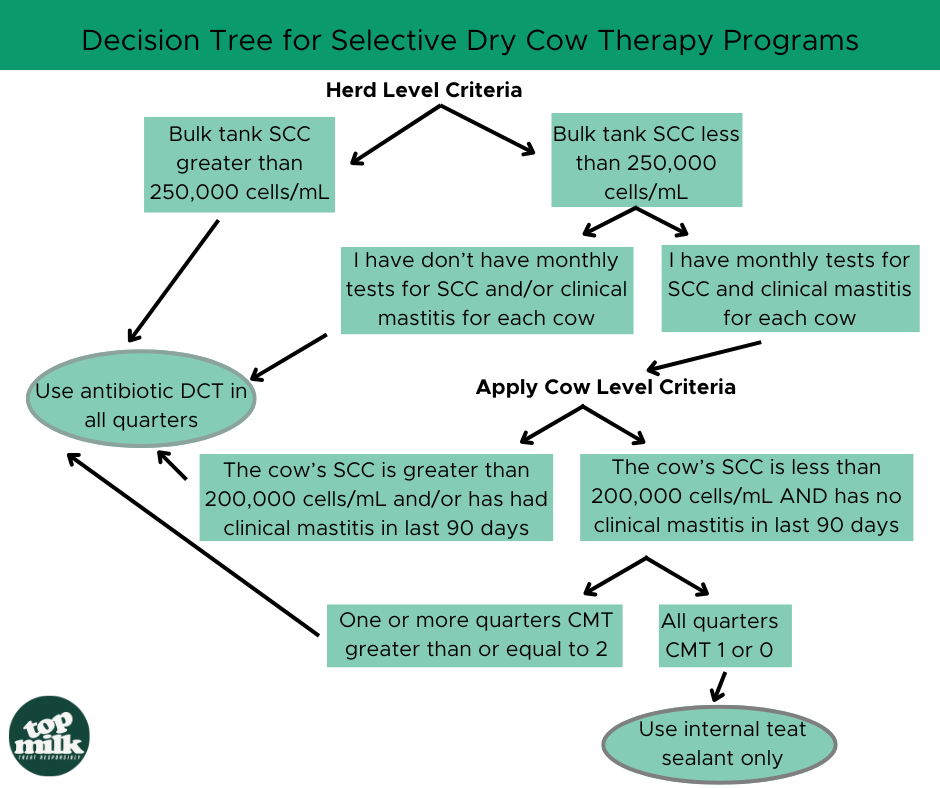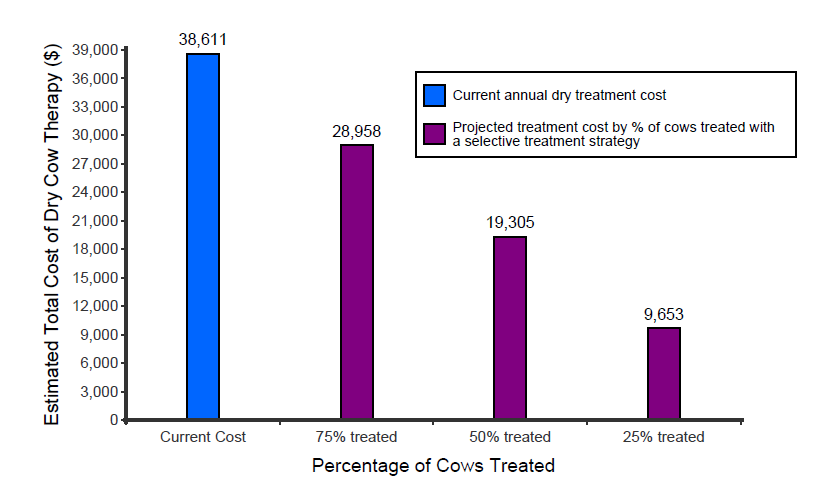
by: Pamela Ruegg and Jaimie Strickland, Michigan State University
Measuring antibiotic usage on your dairy farm is the first step to tackling a complex issue. Dairy farmers must balance animal welfare concerns, cost of treatment, and cost of discarded milk. Reducing antibiotic usage isn’t as simple as just using less without specific protocols, safeguards for animal health and clear goals. Farmers may consider implementing selective dry cow therapy on their farms to reduce antibiotic usage.
What is selective dry cow therapy?
Many farms use blanket dry cow therapy (BDCT), the practice of treating all cows at dry off, or the end of milking, with antibiotics in each quarter along with teat sealant. While this practice allows farm employees to treat all cows identically, it can contribute to greater antibiotic usage and increased costs, especially when not all cows need antibiotic treatment. Selective dry cow therapy (SDCT) uses the cow’s past and current infection status to determine if antibiotics are needed at dry off or if only teat sealant is sufficient.
Is selective dry cow therapy right for my farm?
Your farm should meet several general criteria before you consider SDCT. This includes
- A bulk tank somatic cell count below 250,000 cells/mL
- Few or no cases of contagious mastitis caused by Staph aureus and Strep agalactiae
- Records of the number and duration of mastitis cases during the last lactation per cow
- Few mastitis infections in early lactation, which typically originate during the dry period
- The ability to use teat sealant on all cows at dry off
Cows are generally eligible for SDCT if they have not had clinical mastitis in the last two weeks of lactation, and if they had one or no cases of clinical mastitis during the entire lactation period. Typically, younger cows in their first lactation are more likely to meet these criteria than older cows. Farmers may consider implementing SDCT only in first lactation animals as they evaluate if the practice benefits their operation. The decision tree below allows farmers to evaluate herd level and cow level characteristics before using SDCT.

How do I choose cows to include?
Some farms collect and culture an aseptic milk sample two days before dry off to confirm that the cow does not have a subclinical mastitis infection that would benefit from antibiotic treatment. Farmers may choose to sample each quarter separately and only treat the affected quarter with antibiotics, treating the others with teat sealant alone. Others may collect a composite milk sample and treat all quarters with antibiotics if the combined sample is found to have clinical mastitis. Both strategies reduce antibiotic usage compared to BDCT, but separate sampling decreases antibiotic usage more than composite sampling. SDCT may also reduce labor and supply costs, as farm employees spend less time and materials administering intramammary antibiotics to fewer cows.
In a recent study by Juliana Leite de Campos and Dr. Pamela Ruegg, researchers found that farms could save an average of $5.37 per cow using SDCT. Using herd health records, they estimated that 51% of cows were eligible for teat sealants only at dry off across all herds. Implementing SDCT in these cows would reduce antibiotic usage and therefore antibiotic costs at dry off by 51%.
How do I implement SDCT on my farm?
If your farm meets the above criteria, SDCT may help you save money and reduce antibiotic usage. Work closely with your veterinarian to confirm your protocols are accurate, employees are well trained, and you can effectively monitor the program to ensure animal welfare and prevent adverse outcomes.
Develop inclusion criteria for selective dry cow therapy that make sense on your farm, such as only considering first lactation animals as you being to implement SDCT as in the example above. Re-evaluate your inclusion criteria each year and monitor the incidence of mastitis in your herd.
Can I save money?
The TopMilk team hosts the Antibiotic Usage Benchmark Tool, a secure online program that allows farmers to enter their electronic treatment records and learn how their antibiotic usage compares to that of other farms. An exciting new feature shows the farm’s current cost of dry cow therapy and estimates of cost savings if the farm treated fewer cows. In the example below, a farm currently spends $38,611 on dry cow therapy per year for 1978 cows. If the farm only treated half of those cows in the following year, they would decrease their costs by half and could save $19,305 just on the cost of antibiotics! The farm could realize additional savings from decreased labor and supply costs as well. Even a smaller decrease in treatment could have big impacts. A 25% reduction in the number of cows treated, or 495 cows in this herd, could decrease antibiotic costs by over $9,600.

Want to learn more? You can input your treatment records at dairyantibioticbenchmark.msu.edu. The whole process takes about an hour.








